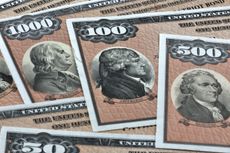Today's Best Values
A company that pays out a lot of cash in proportion to its price is a good buy.

One of the strangest developments during the recent bear market was the unexpected weakness of value stocks relative to growth stocks. This defies the conventional wisdom, which holds that because value stocks are, by definition, bargain priced, they should perform better in down markets than growth stocks, which typically represent the high-priced merchandise.
A value stock can come in a number of stripes. It may be one that boasts a high dividend yield, or one that sells at a low ratio to the underlying company's profits or book value (assets minus liabilities). Growth companies, by contrast, are those with swiftly rising earnings and shares that often trade at high price-earnings and price-to-book-value ratios.
Bear trouble
Because of their lofty values, growth stocks have farther to fall, and in a down market they can descend rapidly. For example, in the 1970s, the last terrible decade for stocks, large-capitalization value stocks returned 12.2% annualized, while large-cap growth stocks returned just 3.4% a year. After inflation, value stocks returned 4.8% annualized; growth stocks lost 4% a year.

Sign up for Kiplinger’s Free E-Newsletters
Profit and prosper with the best of expert advice on investing, taxes, retirement, personal finance and more - straight to your e-mail.
Profit and prosper with the best of expert advice - straight to your e-mail.
Probably the best way to compare growth and value today is through the Standard & Poor's 500/Citigroup Value and Growth indexes. They divide the large-company stocks of Standard & Poor's 500-stock index into two camps using seven measures, including five-year earnings growth and price-to-sales ratio. During the intense bear market from October 9, 2007, through March 9, 2009, the Value index plunged 61% while the Growth index shed 49%. The entire S&P 500 sank 55%.
What's going on?
First, the instability in the economy makes most traditional value indicators irrelevant. What does P/E mean when earnings are volatile or nonexistent? How do you get a handle on the book value of a company if the market for its assets (such as real estate or machinery) is thin or even absent?
Second, in times of extreme trouble (as opposed to a run-of-the-mill bear market), investors turn to strong profit makers -- when they can find them -- rather than to companies whose shares are merely cheap. If everything is undervalued, why not own shares of more-profitable companies, even if they are more expensive? The current period can be compared to the Great Depression. During the 1930s, growth clobbered value by an average of seven percentage points per year.
A third explanation may be that the recent bear market and the Depression of the 1930s were anomalies. Maybe no clear value-growth pattern exists. Even so, investors appear to be seeking safety in growth rather than going for value stocks, and in these times, that's a smart move (for a long-term perspective, see Bu & yHold? You Bet).
Investors need a more limited definition of value -- one that's appropriate for an age of financial uncertainty. Three characteristics count the most:
1. Dividends. While a price-earnings ratio may mean little these days, the ratio of a stock's annual dividend to its price (that is, its yield) is still a strong indicator (though hardly a perfect indicator; see 7 Ways Your Money Will Never Be the Same). You can't fake cash. A company that pays out a lot of cash in proportion to its price is a good buy. And a tradition of increasing dividends provides added assurance in a volatile market (see Stocks That Pay Rising Dividends).
A good place to start is with "dividend aristocrats" -- members of the S&P 500 that have boosted their dividends annually for at least the past 25 years. At the beginning of 2009, there were 52, and their perform-ance has been strikingly superior to that of large-cap stocks as a whole. SPDR S&P Dividend fund (symbol SDY), an exchange-traded fund that tracks the index, lost 24% over the past year through May 31, beating the S&P 500 by nine percentage points.
The ETF doesn't have a long track record, but for the seven-year period that ended last December, the S&P 500 Dividend Aristocrats index itself returned 2.9% annualized, while the S&P 500 lost 1.7% a yearÑand the aristocrats were significantly less volatile.
[page break]
The list is refreshed once a year, and the current one includes several intriguing companies in the sort of boring industries that I admire, including RPM International (RPM), which makes specialty chemicals and has a yield of 5.3% as of June 5; Stanley Works (SWK), tools, with a yield of 3.6%; Bemis (BMS), packaging, 3.5%; and Clorox (CLX), consumer products, 3.5%.
As with earnings, there's no guarantee that dividends will persist. But companies are reluctant to cut their payouts, so they tend to set them and raise them with care. Still, S&P will purge some of the aristocrats at year-end for lowering their distributions. Among those getting the boot are General Electric (GE) and regional bank BB&T (BBT), both of which I nonetheless continue to like.
2. Cash. The best shelter from the current storm is a strong balance sheet, highlighted by an abundance of cash and a paucity of debt. An example is Celestica (CLS), a contract electronics manufacturer based in Toronto. Spun off from IBM in 1996, Celestica had $1.1 billion in cash and $585 million in debt as of March 31. The cash amounted to $4.72 per share for a stock that closed June 5 at $7.45.
Each week, the Value Line Investment Survey publishes a list of "bargain-basement stocks," those with a low ratio of price to net working capital. The latter measure is defined as current assets (such as cash and receivables) minus all liabilities, including long-term debt and preferred stock. Celestica led the list, with a ratio of just 1.6, a low number for a company that generates positive cash flow.
Another attractive bargain-basement stock is an old favorite of mine with a magical name: National Presto Industries (NPK), which makes everything from pizza ovens to ammunition to adult diapers. The company has no debt and $149 million in cash. Value Line gives it a top ranking of 1 for timeliness and an average 3 for safety. National Presto's stock has actually risen in the past two years -- by about 30%. But by standard measures of value, it remains delightfully unloved.
3. Ostracism. From time to time, investors send entire sectors into exile. But within those sectors you can often find perfectly good companies that suffer with their cohorts. Topping the list of detested industries today, of course, is finance, so it's a rich field.
The banking industry has been shaken to its core, and because key measurements remain opaque, it's tough to assess the soundness of individual firms. Still, M&T Bank (MTB) is a value stock that's hard to resist. It has a tradition of good management, a history of rising dividends that puts the company on the aristocrats list (although M&T has not yet raised its payout in 2009), and, thanks to a recent acquisition, ownership of the largest number of banks in the Baltimore-Washington area.
Also among the ostracized are insurers. W.R. Berkley (WRB) and Chubb (CB) are two respected property-and-casualty firms whose shares have stood up far better than those of their peers. Berkley suffered an earnings decline last year, but 2009 looks better. And with the stock selling at nearly ten times estimated '09 earnings, the price is right. Chubb is an S&P aristocrat with a P/E of 8 and a yield of 3.4%.
Hybrids
How about stocks that offer value and growth? Value Line recently compiled a list of low-risk, dividend-growth stocks. Companies had to pass a screen that required an average payout growth rate of 5% for the past five years, a minimum yield for the year ahead of 4%, above-average financial strength, and at least average expected price appreciation for the next six to 12 months.
Sixteen stocks made the cut. I particularly like Paychex (PAYX), which provides payroll and other business services and yields 4.5% -- a handsome figure at a time when the ten-year Treasury is yielding 3.9%. Paychex has had double-digit average annual earnings growth over the past five years, and projected growth is in the double digits for the next five as well.
In today's environment, you need more justification to invest in a company than value alone. You need firms with solid balance sheets, low prices and the market power to grow. And, yes, such companies still exist.
James K. Glassman, former Under Secretary of State, is president of the World Growth institute. He is working on a new book on investing, to be published next year.

-
 Strategies to Optimize Your Social Security Benefits
Strategies to Optimize Your Social Security BenefitsTo maximize what you can collect, it’s crucial to know when you can file, how delaying filing affects your checks and the income limit if you’re still working.
By Jason “JB” Beckett Published
-
 Don’t Forget to Update Beneficiaries After a Gray Divorce
Don’t Forget to Update Beneficiaries After a Gray DivorceSome states automatically revoke a former spouse as a beneficiary on some accounts. Waivers can be used, too. Best not to leave it up to your state, though.
By Andrew Hatherley, CDFA®, CRPC® Published
-
 Best Banks for High-Net-Worth Clients
Best Banks for High-Net-Worth Clientswealth management Kiplinger's 2023 list of the best banks for higher-net-worth clients.
By Lisa Gerstner Published
-
 Stock Market Holidays in 2024: NYSE, NASDAQ and Wall Street Holidays
Stock Market Holidays in 2024: NYSE, NASDAQ and Wall Street HolidaysMarkets When are the stock market holidays? Take a look at which days the NYSE, Nasdaq and bond markets are off in 2024.
By Kyle Woodley Last updated
-
 Stock Market Trading Hours: What Time Is the Stock Market Open Today?
Stock Market Trading Hours: What Time Is the Stock Market Open Today?Markets When does the market open? It's true the stock market does have regular hours, but trading doesn't necessarily stop when the major exchanges close.
By Michael DeSenne Last updated
-
 Bogleheads Stay the Course
Bogleheads Stay the CourseBears and market volatility don’t scare these die-hard Vanguard investors.
By Kim Clark Published
-
 I-Bond Rate Is 5.27% for Next Six Months
I-Bond Rate Is 5.27% for Next Six MonthsInvesting for Income I-Bonds issued November 1, 2023 through April 30, 2024 will have a rate of 5.27%.
By David Muhlbaum Last updated
-
 What Are I-Bonds?
What Are I-Bonds?savings bonds Inflation has made Series I savings bonds enormously popular with risk-averse investors. So how do they work?
By Lisa Gerstner Last updated
-
 This New Sustainable ETF’s Pitch? Give Back Profits.
This New Sustainable ETF’s Pitch? Give Back Profits.investing Newday’s ETF partners with UNICEF and other groups.
By Ellen Kennedy Published
-
 As the Market Falls, New Retirees Need a Plan
As the Market Falls, New Retirees Need a Planretirement If you’re in the early stages of your retirement, you’re likely in a rough spot watching your portfolio shrink. We have some strategies to make the best of things.
By David Rodeck Published